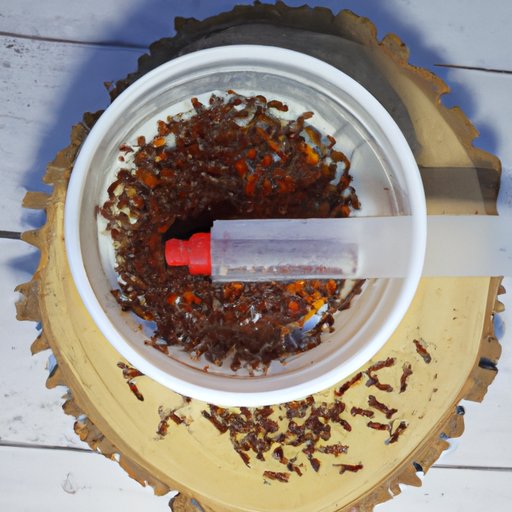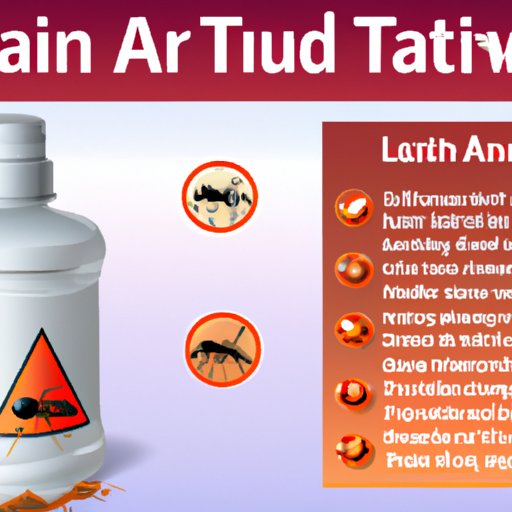Exploring the Science Behind Liquid Ant Bait: How Does it Work?
Liquid ant bait is a type of pest control product used to control ant populations. It uses an attractant to lure ants away from their nest and into the bait, where they ingest an active ingredient that kills them. It’s a highly effective way to get rid of ants without having to resort to harsh chemical sprays or baits.
But how exactly does liquid ant bait work? Let’s take a closer look at this popular pest control product and explore the science behind it.
What is Liquid Ant Bait?
Liquid ant bait is a type of insecticide designed to be attractive to ants. It contains an active ingredient that kills the ants when ingested. The active ingredient is usually an insecticide such as boric acid or fipronil, but there are other types of active ingredients available as well. Liquid ant bait also contains an attractant, which is usually a sweet-smelling liquid that lures the ants to the bait.
The bait is typically sold in pre-filled syringes or containers, which can then be placed around areas where ants are present. The ants will be attracted to the sweet smell of the bait and will ingest the active ingredient, which will kill them within a few days.
How Does It Work?
When using liquid ant bait, the active ingredient is slowly released over time. This allows the ants to feed on the bait without immediately dying. As the ants feed on the bait, they will ingest the active ingredient, which will slowly kill them over a period of several days. The slow release of the active ingredient also allows for more ants to feed on the bait and ingest the poison, resulting in a greater number of ants being killed.
The attractant in the bait is usually a sweet-smelling liquid, such as sugar water or honey. This attracts the ants to the bait, and they will begin to feed on it. As they feed, they will ingest the active ingredient, which will eventually kill them.
What Are the Benefits of Using Liquid Ant Bait?
Liquid ant bait is an effective and safe way to get rid of ants. It is easy to use and doesn’t require any special tools or equipment. Additionally, it is less likely to cause harm to beneficial insects, pets, and people than traditional insecticides. The slow release of the active ingredient also ensures that more ants will be killed, and the bait can be placed in hard-to-reach areas where traditional insecticides may not be as effective.
An Overview of Liquid Ant Bait: What Makes It Effective?
There are several different types of liquid ant bait available on the market today. The most common types are bait traps, syringe applicators, and gel applicators. Each type has its own advantages and disadvantages, so it’s important to research the various types of liquid ant bait before making a purchase.
Most liquid ant baits contain one or more active ingredients. Common active ingredients include boric acid, fipronil, and hydramethylnon. Each of these active ingredients has its own unique properties and effects on ants, so it’s important to read the label carefully to make sure you’re using the right type of liquid ant bait for your particular situation.
In addition to the active ingredients, liquid ant bait also contains an attractant, which is usually a sweet-smelling liquid that lures the ants to the bait. Different types of attractants can be used, such as sugar water, honey, or syrup. The attractant helps to ensure that the ants will be drawn to the bait and will ingest the active ingredient.
The Benefits of Using Liquid Ant Bait for Pest Control
Liquid ant bait is an effective way to control ant populations. It is easy to use, requires no special tools or equipment, and is less likely to cause harm to beneficial insects, pets, and people than traditional insecticides. Additionally, the slow release of the active ingredient ensures that more ants will be killed, and the bait can be placed in hard-to-reach areas where traditional insecticides may not be as effective.
The active ingredients in liquid ant bait are also very effective at killing ants. Boric acid is a common active ingredient and is a stomach poison that affects the nervous system of the ant. Fipronil is another common active ingredient that disrupts the nervous system of the ant, preventing it from functioning properly. Hydramethylnon is another active ingredient that interferes with the metabolism of the ant, causing it to die.

A Look at the Ingredients in Liquid Ant Bait and How They Function
Boric acid is a common active ingredient in liquid ant bait and is a stomach poison that affects the nervous system of the ant. Fipronil is another common active ingredient that disrupts the nervous system of the ant, preventing it from functioning properly. Hydramethylnon is another active ingredient that interferes with the metabolism of the ant, causing it to die.
Other active ingredients in liquid ant bait include pyrethrins, which affect the nervous system of the ant; spinosad, which is a natural insecticide derived from soil bacteria; and imidacloprid, which is a neurotoxin that affects the nervous system of the ant.

How to Use Liquid Ant Bait and Get the Best Results
When using liquid ant bait, it’s important to follow the instructions on the package carefully. Safety precautions should always be taken when applying the bait, such as wearing gloves and avoiding contact with skin and eyes. Additionally, it’s important to place the bait in areas where it won’t be accessible to children or pets.
It’s also important to apply the bait correctly. When using gel applicators, it’s best to apply the bait directly to surfaces where ants are present. For syringe applicators, it’s best to apply the bait in cracks and crevices where ants tend to hide. Bait traps should be placed near the ant’s nest or along trails leading to the nest.
If you’re having trouble getting the results you want with liquid ant bait, there are a few troubleshooting tips that may help. First, make sure you’re using the right type of bait for your particular situation. Second, make sure the bait is placed in the right locations. Finally, make sure you’re using enough bait; if the bait isn’t being eaten quickly enough, you may need to increase the amount you’re using.
Conclusion
Liquid ant bait is an effective and safe way to control ant populations. It is easy to use and doesn’t require any special tools or equipment. Additionally, it is less likely to cause harm to beneficial insects, pets, and people than traditional insecticides. Before using liquid ant bait, it’s important to read the label carefully and follow the instructions for proper application.
(Note: Is this article not meeting your expectations? Do you have knowledge or insights to share? Unlock new opportunities and expand your reach by joining our authors team. Click Registration to join us and share your expertise with our readers.)
